
The Straight Dance, also known as Southern Straight Dance or Southern Traditional, is a style of Native American pow wow dancing. The dance recounts the story of hunting or war parties searching for the enemy. [1]

The Straight Dance, also known as Southern Straight Dance or Southern Traditional, is a style of Native American pow wow dancing. The dance recounts the story of hunting or war parties searching for the enemy. [1]
The Straight Dance is attributed to the Southern Plains tribes in Oklahoma. The Hethuska, a prominent war society of the Poncas, is commonly attributed with the creation of the dance; however, the Pawnee, Omaha, Osage, and Kiowa tribes have sometimes been credited with creating the dance. [2] [3] In the 20th century, when several warrior societies began to dissolve, the purpose of the war dances changed. The Straight Dance evolved from these war dances as a way to keep the tradition and history. [2]

The Straight Dance is considered to be more dignified or formal than other pow wow dances. [3] [4] The general steps for the dance involve a "toe-heel" step where the dancer taps the ground with his toe on the first drum beat and then places his whole foot down on the second beat. The dance resembles a hunting or warring party and therefore the dancer must not dance backwards as that would symbolize a retreat from the enemy. [5] Instead they always dance clockwise around the circle. As a Southern dance, it is danced to a Southern Drum. [6]
The Straight Dance regalia consists of a ribbon shirt, tab leggings, aprons, and a headdress (usually a roach or a turban). These are decorated and accessorized with finger-woven garters, beaded belts, vests or bandoliers, German silver armbands, and scarfs. One of the main features of the Straight Dance is an otter dragger, also referred as an otterhide, which hangs from the dancer's back and drags on the ground. It is normally decorated with medals, beadwork, ribbonwork, or feathers. Straight dancers generally carry a fan, mirror board, or tail stick in their hands. [3] [5]

The Arapaho are a Native American people historically living on the plains of Colorado and Wyoming. They were close allies of the Cheyenne tribe and loosely aligned with the Lakota and Dakota.
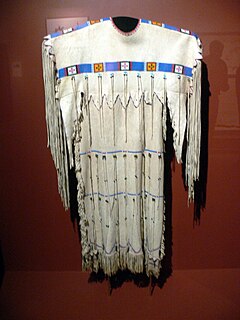
The Cheyenne are one of the indigenous people of the Great Plains whose language is of the Algonquian language family. The Cheyenne comprise two Native American tribes, the Só'taeo'o or Só'taétaneo'o and the Tsétsêhéstâhese. These tribes merged in the early 19th century. Today, the Cheyenne people are split into two federally recognized Nations: the Southern Cheyenne, who are enrolled in the Cheyenne and Arapaho Tribes in Oklahoma, and the Northern Cheyenne, who are enrolled in the Northern Cheyenne Tribe of the Northern Cheyenne Indian Reservation in Montana.
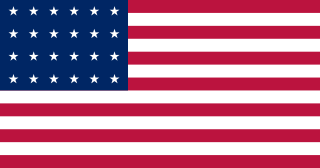
The Indian Territory and the Indian Territories are terms that generally described an evolving land area set aside by the United States Government for the relocation of Native Americans who held aboriginal title to their land as a sovereign independent state. In general, the tribes ceded land they occupied in exchange for land grants in 1803. The concept of an Indian Territory was an outcome of the US federal government's 18th- and 19th-century policy of Indian removal. After the American Civil War (1861–1865), the policy of the US government was one of assimilation.

The Pawnee are a Central Plains Indian tribe that historically were based in Nebraska and Kansas and currently are based in Oklahoma. Today they are the federally recognized Pawnee Nation of Oklahoma, who are headquartered in Pawnee, Oklahoma. Their Pawnee language belongs to the Caddoan language family, and their names for themselves is Chatiks si chatiks or "Men of Men".

The Blackfoot Confederacy, Niitsitapi or Siksikaitsitapi, is a historic collective name for linguistically related groups that make up the Blackfoot or Blackfeet people: the Siksika ("Blackfoot"), the Kainai or Blood, and two sections of the Peigan or Piikani – the Northern Piikani (Aapátohsipikáni) and the Southern Piikani. Broader definitions include groups such as the Tsúùtínà (Sarcee) and A'aninin who spoke quite different languages but allied with or joined the Blackfoot Confederacy.

Kiowa people are a Native American tribe and an indigenous people of the Great Plains of the United States. They migrated southward from western Montana into the Rocky Mountains in Colorado in the 17th and 18th centuries, and finally into the Southern Plains by the early 19th century. In 1867, the Kiowa were moved to a reservation in southwestern Oklahoma.
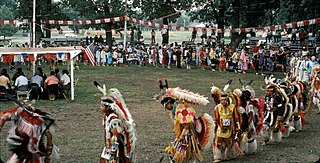
A pow wow is a sacred social gathering held by many North American indigenous communities. A modern pow wow is a specific type of event for Tribal American people to meet and dance, sing, socialize, and honor their cultures. Pow wows may be private or public. There is generally a dancing competition, with many types of traditional dances, often with significant prize money awarded. Pow wows vary in length from a one-day event, to major pow wows called for a special occasion which can be up to one week long.

The Caddo Nation is a confederacy of several Southeastern Native American tribes. Their ancestors historically inhabited much of what is now East Texas, Louisiana, and portions of southern Arkansas and Oklahoma. They were descendants of the Caddoan Mississippian culture that constructed huge earthwork mounds at several sites in this territory, beginning about 800 CE. In the early 19th century, Caddo people were forced to a reservation in Texas; they were removed to Indian Territory in 1859.

The Pend d’Oreille, also known as the Kalispel, are Indigenous peoples of the Northwest Plateau. Today many of them live in Montana and eastern Washington. The Kalispel peoples referred to their primary tribal range as Kaniksu.

Plains Indians or Indigenous peoples of the Great Plains and Canadian Prairies are the Native American tribes and First Nation band governments who have historically lived on the Interior Plains of North America. While hunting-farming cultures have lived on the Great Plains for centuries prior to European contact, the region is known for the horse cultures that flourished from the 17th century through the late 19th century. Their historic nomadism and armed resistance to domination by the government and military forces of Canada and the United States have made the Plains Indian culture groups an archetype in literature and art for Native Americans everywhere.
Kiowa music is the music of the Kiowa Tribe of Oklahoma. The Kiowa are a federally recognized tribe, meaning they have a functioning government-to-government relationship with the United States government.

Fancy dance, Pan-Indian dancing, Fancy Feather or Fancy War Dance is a style of dance some believe was originally created by members of the Ponca tribe in the 1920s and 1930s, in an attempt to preserve their culture and religion. It is loosely based on the War dance. Fancy dance was considered appropriate to be performed for visitors to reservations and at "Wild West" shows. But today, fancy dancers can be seen at many powwows across the nation and even the world.
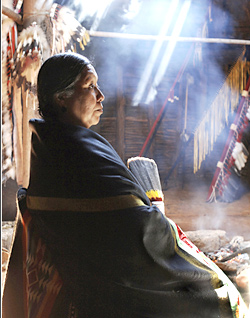
The Plains Apache are a small Southern Athabaskan group who live on the Southern Plains of North America, in close association with the linguistically unrelated Kiowa Tribe. Today, they are centered in Southwestern Oklahoma and Northern Texas and are federally recognized as the Apache Tribe of Oklahoma.
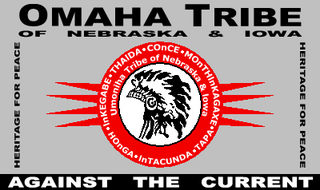
The Omaha are a federally recognized Midwestern Native American tribe who reside on the Omaha Reservation in northeastern Nebraska and western Iowa, United States. The Omaha Reservation lies primarily in the southern part of Thurston County and northeastern Cuming County, Nebraska, but small parts extend into the northeast corner of Burt County and across the Missouri River into Monona County, Iowa. Its total land area is 796.355 km2 (307.474 sq mi) and a population of 5,194 was recorded in the 2000 census. Its largest community is Macy.

The Stomp Dance is performed by various Eastern Woodland tribes and Native American communities, including the Muscogee, Yuchi, Cherokee, Chickasaw, Choctaw, Delaware, Miami, Caddo, Tuscarora, Ottawa, Quapaw, Peoria, Shawnee, Seminole, Natchez, and Seneca-Cayuga tribes. Stomp Dance communities are active in North Carolina, Oklahoma, Alabama, Mississippi, and Florida.

The Gourd Dance is a social dance.

Bison hunting was an activity fundamental to the economy and society of the Plains Indians peoples who inhabited the vast grasslands on the Interior Plains of North America, prior to the animal's near-extinction in the late nineteenth century following US expansion into the West. Bison hunting was an important spiritual practice and source of material for these groups, especially after the European introduction of the horse in the 16th through 18th centuries enabled new hunting techniques. The species' dramatic decline was the result of habitat loss due to the expansion of ranching and farming in western North America, industrial-scale hunting practiced by non-indigenous hunters, increased indigenous hunting pressure due to non-indigenous demand for bison hides and meat, and cases of deliberate policy by settler governments to destroy the food source of the native Indian peoples during times of conflict.

The Halluci Nation, formerly known as A Tribe Called Red, is a Canadian electronic music group who blend instrumental hip hop, reggae, moombahton and dubstep-influenced dance music with elements of First Nations music, particularly vocal chanting and drumming. Based in Ottawa, Ontario, the group consists of Tim "2oolman" Hill, and Ehren "Bear Witness" Thomas. Former members include co-founder DJ Jon Deck and Dan "DJ Shub" General, who left the band for personal reasons in spring 2014, and was replaced by Hill. Co-founder Ian "DJ NDN" Campeau left the band for health reasons in October 2017, with the band opting to remain a duo for the time being.

The grass dance or Omaha dance is a style of modern Native American men's pow wow dancing originating in the warrior societies on the Northern Great Plains. Unlike most forms of pow wow dancing, the grass dance regalia generally has no feathers besides the occasional roach feather. The regalia consists of brightly colored fringe made of either yarn, broadcloth, or ribbon.

Native American cultures across the United States are notable for their wide variety and diversity of lifestyles, regalia, art forms and beliefs. The culture of indigenous North America is usually defined by the concept of the Pre-Columbian culture area, namely a geographical region where shared cultural traits occur. The northwest culture area, for example shared common traits such as salmon fishing, woodworking, large villages or towns and a hierarchical social structure.
| Wikimedia Commons has media related to Straight Dance . |